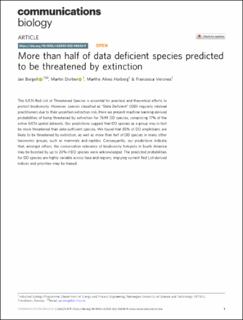| dc.contributor.author | Borgelt, Jan | |
| dc.contributor.author | Dorber, Martin | |
| dc.contributor.author | Høiberg, Marthe Alnes | |
| dc.contributor.author | Verones, Francesca | |
| dc.date.accessioned | 2023-03-10T09:12:53Z | |
| dc.date.available | 2023-03-10T09:12:53Z | |
| dc.date.created | 2022-10-06T12:52:58Z | |
| dc.date.issued | 2022 | |
| dc.identifier.citation | Communications Biology. 2022, 5 (1), . | en_US |
| dc.identifier.issn | 2399-3642 | |
| dc.identifier.uri | https://hdl.handle.net/11250/3057576 | |
| dc.description.abstract | The IUCN Red List of Threatened Species is essential for practical and theoretical efforts to protect biodiversity. However, species classified as “Data Deficient” (DD) regularly mislead practitioners due to their uncertain extinction risk. Here we present machine learning-derived probabilities of being threatened by extinction for 7699 DD species, comprising 17% of the entire IUCN spatial datasets. Our predictions suggest that DD species as a group may in fact be more threatened than data-sufficient species. We found that 85% of DD amphibians are likely to be threatened by extinction, as well as more than half of DD species in many other taxonomic groups, such as mammals and reptiles. Consequently, our predictions indicate that, amongst others, the conservation relevance of biodiversity hotspots in South America may be boosted by up to 20% if DD species were acknowledged. The predicted probabilities for DD species are highly variable across taxa and regions, implying current Red List-derived indices and priorities may be biased. | en_US |
| dc.language.iso | eng | en_US |
| dc.publisher | Nature | en_US |
| dc.rights | Navngivelse 4.0 Internasjonal | * |
| dc.rights.uri | http://creativecommons.org/licenses/by/4.0/deed.no | * |
| dc.title | More than half of data deficient species predicted to be threatened by extinction | en_US |
| dc.title.alternative | More than half of data deficient species predicted to be threatened by extinction | en_US |
| dc.type | Peer reviewed | en_US |
| dc.type | Journal article | en_US |
| dc.description.version | publishedVersion | en_US |
| dc.source.pagenumber | 9 | en_US |
| dc.source.volume | 5 | en_US |
| dc.source.journal | Communications Biology | en_US |
| dc.source.issue | 1 | en_US |
| dc.identifier.doi | 10.1038/s42003-022-03638-9 | |
| dc.identifier.cristin | 2059159 | |
| cristin.ispublished | true | |
| cristin.fulltext | original | |
| cristin.qualitycode | 1 | |

